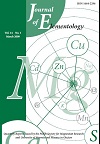Effect of nitrogen fertilization on the yield and nutritive value of Beta vulgaris L.
Issue: 1/2012
Recevied: No data
Accepted: Brak danych
Published: March 22, 2012
Authors:
Brak danych
Categories: Horticulture and forestry
DOI: 10.5601/jelem.2012.17.1.02
Abstract:
Leaf beet is one of several types of Beta vulgaris L. The vegetable originates from the Mediterranean area but is currently grown on a large scale in the US and Western Europe, e.g. Switzerland, Germany, France or England. In Poland, it is a less known vegetable, despite its high content of many valuable nutrients and excellent taste. One of the main factors affecting the size and quality of yield is nitrogen fertilization. Nitrogen is a structural element of plants and its deficiency significantly inhibits production of new plant tissue. This element is a component of nucleic acids, nucleotides, coenzymes, chlorophyll, phytohormones and cytokinines. The aim of this study was to conduct research on the effect of varied nitrogen fertilization on yielding and chemical composition of aerial parts of leaf beet. The experiment used three doses of nitrogen (0.2, 0.4, 0.6 g N dm–3 of medium) in the form of ammonium nitrate or urea. Plants were cultivated in a greenhouse, in 4-litre pots filled with high moor peat limed to pH of 5.6 with waste chalk. The following fertilizers were used in the experiment: ammonium nitrate – 34% N, urea – 46% N, monobasic potassium phosphate – 23% P, 28.2% K, magnesium sulphate – 15.6% Mg, and microelements. In the cultivation of leaf beet, application of 0.4 g N dm–3 NH4NO3 proved to be most beneficial as it led to the highest yield of fresh mass of leaves and highest content of L-ascorbic acid, whereas application of CO(NH2)2 in the amount of 0.2 g N dm–3 of the growth medium proved to be best, as it resulted in the lowest nitrate share in the dry mass of leaves. Regardless of the type of nitrogen fertilization, growth in the total salt concentration (EC) in the medium was shown as an effect of increasing doses of the applied fertilizers. Increasing the nitrogen concentration by 100% in the growth medium in relation to the lowest dose raised the Fe and Cu content in beet leaves and depressed that of Zn and Mn irrespective of the applied nitrogen fertilization.
Citation:

Dzida K., Jarosz Z., Michałojć Z. 2012. Effect of nitrogen fertilization on the yield and nutritive value of Beta vulgaris L. J. Elem. 17(1): 19-29.10.5601/jelem.2012.17.1.02.
Keywords:
Beta vulgaris L., doses and forms of nitrogen, nitrates, medium, macro- and micronutrients
About issue:

17.1.2012
Jsite


